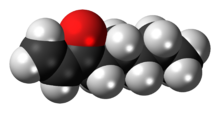 | |
 | |
| Names | |
|---|---|
| Preferred IUPAC name Oct-1-en-3-one | |
| Identifiers | |
| CAS Number | |
| 3D model (JSmol) | |
| ChemSpider | |
| ECHA InfoCard | 100.022.116 |
| PubChem CID | |
| UNII | |
| CompTox Dashboard (EPA) | |
InChI
| |
SMILES
| |
| Properties | |
| Chemical formula | C8H14O |
| Molar mass | 126.20 g/mol |
| Boiling point | 56–60 °C (133–140 °F; 329–333 K) at 16 mm Hg |
| Hazards | |
| GHS labelling: | |
| Pictograms |  
|
| NFPA 704 (fire diamond) |
 |
| Flash point | 35 °C (95 °F; 308 K) |
| Safety data sheet (SDS) | Fisher Scientific |
| Related compounds | |
| Related enones | Methyl vinyl ketone |
| Related compounds | 1-Octene |
| Except where otherwise noted, data are given for materials in their standard state (at 25 °C , 100 kPa).
| |
Oct-1-en-3-one (CH2=CHC(=O)(CH2)4CH3), also known as 1-octen-3-one or amyl vinyl ketone, is the odorant that is responsible for the typical "metallic" smell of metals and blood coming into contact with skin. Oct-1-en-3-one has a strong metallic mushroom-like odor with an odor detection threshold of 0.03–1.12 μg/m and it is the main compound responsible for the "smell of metal", followed by decanal (smell: orange skin, flowery) and nonanal (smell: tallowy, fruity). Oct-1-en-3-one is the degradative reduction product of the chemical reaction of skin lipid peroxides and Fe. Skin lipid peroxides are formed from skin lipid by oxidation, either enzymatically by lipoxygenases or by air oxygen. Oct-1-en-3-one is a ketone analog of the alkene 1-octene.
Natural occurrences
It is also produced by Uncinula necator, a fungus that causes powdery mildew of grape.
See also
- Odorant
- 1-Octen-3-ol, the alcohol analog that is used by mosquitoes as an odor cue
References
- "Human Metabolome Database: Showing metabocard for 1-Octen-3-one (HMDB0031309)". hmdb.ca. Retrieved 5 October 2024.
- D. Glindemann, A. Dietrich, H. Staerk, P. Kuschk (2006). "The Two Odors of Iron when Touched or Pickled: (Skin) Carbonyl Compounds and Organophosphines". Angewandte Chemie International Edition. 45 (42): 7006–7009. doi:10.1002/anie.200602100. PMID 17009284.
{{cite journal}}: CS1 maint: multiple names: authors list (link) - Supporting information for the Glindemann article
- Darriet P, Pons M, Henry R, et al. (May 2002). "Impact odorants contributing to the fungus type aroma from grape berries contaminated by powdery mildew (Uncinula necator); incidence of enzymatic activities of the yeast Saccharomyces cerevisiae". J. Agric. Food Chem. 50 (11): 3277–82. doi:10.1021/jf011527d. PMID 12009998.